Brisbane St, Launceston. Google Maps.
Original buildings constructed & licensed in the early 1820s.
Photo c.1880, older building prior to redevelopment (image 7, might be a direct link)
Brisbane Street, c. 1880 (Launceston Hotel second from right)
Photo, interior staircase

Earliest mention I have found is an advertisement from August, 1823, with other horse related ads in the following months (see below), and Richard White appears in the list of person licensed to sell Spirits, Wines, and Beer for the same year.
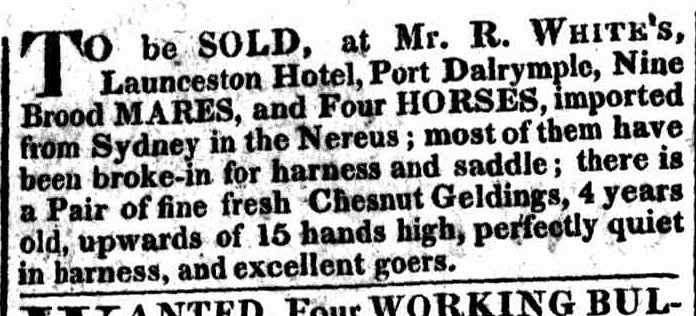
Hobart Town Gazette, 9 August 1823

Hobart Town Gazette, 1 November 1823
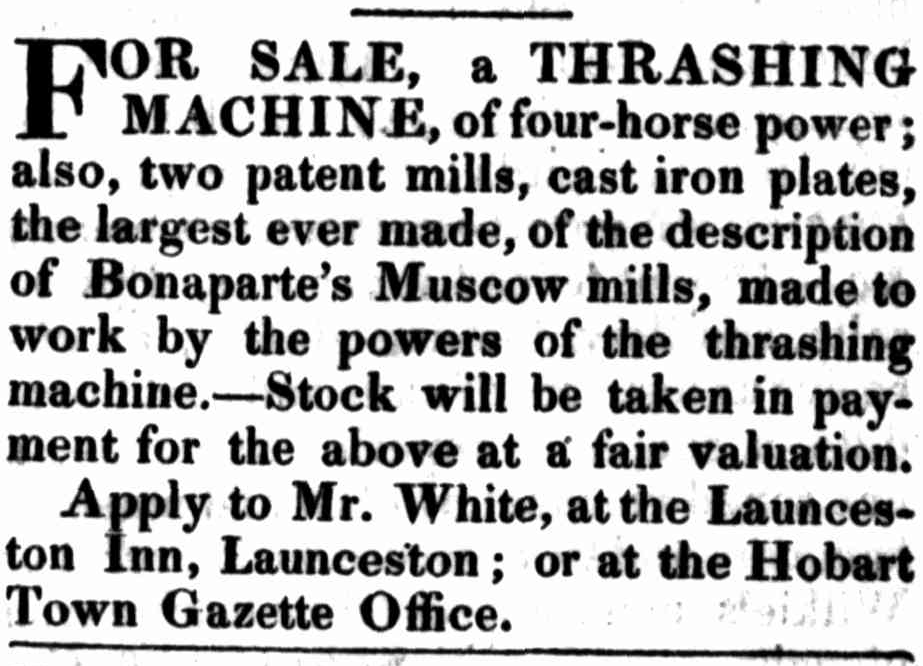
(Note use of “Inn”)

Photo by William Cawston, c.1880, from the State Library of Victoria
From a lecture by Mr E. Whitfield. 1897:
In 1820 came the first public house, “The Black Swan,” kept by G. Burgess, corner of Brisbane and Wellington streets. Then came in 1823 the Launceston, the Plough Inn, kept by W. Field, where Hart and Sons are now, and the Hope and Anchor, kept by Nat. Lucas. The Launceston Hotel, was built by Richard White, familiarly known as “Dicky White.” He was a Norfolk Islander, as also was his mate or comrade, Mr. Whittle (afterwards of the White Hills). In those days any free man could mark off a piece of land, settle on it, and procure a title afterwards. White pegged out the present site of the Launceston Hotel, and Whittle squatted alongside of him, and built a “wattle and daub” hut in the centre of what is now St. Johnstreet. White and Whittle owned the land including what is now St. John -street as far as Mr. A. J. Hall’s residence, and along Brisbane-street to Wade’s right-of way. Where the Bijou Theatre now stands was a large water hole where the bullocks were taken to water. When York-street was surveyed White and Whittle gave the land required to continue St. John-street to York-street. White built the Launceston Hotel, and also erected an auction mart on what is now Frank Hart’s corner, and carried on business for some years.
Launceston Examiner, 6 February 1897
First in order of time as well as in reputation we have the Launceston Hotel, where, on the site of one of our Tasmanian antiquities the old “Launceston” a commodious and elegant building was erected between two and three years ago by the present proprietor, Mr. William Carpenter. This building was at once a credit to the proprietor, the architect, and the town. The front in Brisbane street was the first innovation here on the prevailing style of hotel architecture, and in the internal arrangement of the building convenience and comfort were specially provided for. The centre of the ground floor consists of a public room, 21 feet by 11 feet; the left wing includes a suite of elegantly furnished rooms, securing privacy and convenience; the bar being in the right wing ‘of the building. The upper floor consists of bed-rooms and parlors most conveniently arranged for the accommodation of families and others visitors; and having in front an airy balcony. The billiard-room adjoins the building at the back, and the stables are entered from St John-street. The reputation of this establishment for respectability has been well sustained, and its commanding position and influential country support give it a prominent place amongst the hotels of the colony.
Examiner, 25 February 1869
THE LAUNCESTON HOTEL.
The sale yesterday, under instructions from the trustees of Carpenter’s estate, of the well-known Launceston Hotel, in Brisbane-street, to Mr. Jas. Barclay for £6500, recalls reminiscences of the changes this hostelry has passed through in the last 60 years.
The original Launceston Hotel was built about 1824 by Mr. Richard White, familiarly known as “Dicky White,” upon the site of the present main building. It was a one-storey wooden building, with a verandah in front, and was used as a hotel, while alongside it, at the corner now occupied by Mr. F. Hart’s three-storeyed establishment, was a one-storey wooden building where Mr. White carried on a second business as an auctioneer. The present Quadrant had then no existence, and Mr. White’s property extended in St. John-street, past where Mr. A. J. Hall’s residence now stands, and along Brisbane street up to the right-of-way in front of Mr. Costain’s shop. The premises now occupied by Mr. A. J. Hall were subsequently built by the late Mr. Wm. Tyson as a residence for Mr. Henry Clayton, jun., and next to it, occupying part of the site of premises now occupied by Mr. Rawson and the Mutual Insurance Company, was a rope walk running back to the rear of the allotment occupied by the late Mr. Morris in George-street. Next to Mr. White’s auction mart at the corner, a two-storey residence was built as a residence for Mr. Benjamin, member of a well known firm of merchants here (the last occupant for many years prior to its demolition being Mr. Norris, the barber). Where the Oddfellows’ Hall now stands, at the rear of the Launceston Hotel stables, was a large pond made for watering bullocks at. The two-storey building in Brisbane-street, which now forms part of the Launceston Hotel, was built by Mr. W. Tyson for Mr. Richard White as a private residence, and next to it in Brisbane-street same his garden, the stables and coach-house being where Mr. M’Lennan’s shop now stands. But while Mr. White was conducting the Launceston Hotel he let the private residence to Captain Ritchie, who was then trading between Launceston and Sydney.
When Mr. White gave up keeping the Launceston Hotel he let it to a man named Judson, who had been in his employ, and from Judson it passed into the occupation of Mr. Kitson, who was lessee at the time of Mr. White’s death in 1844, and for some years afterwards until his death. The property had at Mr. White’s death passed by will into the possession of the Clayton family, and about 1850 they sold the Launceston Hotel and yard, and the old auction mart adjoining, to Mr. W. Carpenter, who built the present main building. The old one-storey building was drawn back, a portion of it being still in existence, and in front of it the present two-storey brick edifice was built, fronting on to the street. Mr. Carpenter conducted the hotel for some years, and died there, and his executors then leased it to a Frenchman named Fassert, noted for his skill as a cook. From him it passed into the occupation of Mr. W. Morrison, who died there, and his widow carried on the business till failing health compelled her retirement some four years ago. The present lessee; Mr. E. H. Panton, then took possession, and though his lease has some time yet to run, is likely to prove the last lessee of this old and favourite hotel, as we understand Mr. Barclay contemplates the erection of business premises on its site at a future date. It was during Mrs. Morrison’s tenancy that the old private residence of Mr. White became incorporated in the hotel, having been either wholly or partially used for residence and business purposes. After Mr. White’s death it was occupied successively by Mr. Francis Evans, Mr. Stuart, Mr. E. Harvey, Mr. P. Hobkirk, and others.
The sub-division of the block formerly Mr. White’s property took place when the present Quadrant was laid out by Mr.Henry Clayton, and the land cut up into building allotments and sold. Mr. B.Hyrons bought one corner of the St. John street end of the Quadrant, and built the old Shakespeare Hotel there, having also a small brewery for a time. The opposite corner was bought by Mr. Price, a baker, who built the existing shop and dwelling house, and the old Theatre Royal was built next to it, where the Oddfellows’ Hall now stands, by a company, and subsequently passed into the possession of the Bank of Tasmania, while the City Hotel, adjoining, was built by the late Mr. Jas. Lilly, of the Salmon and Ball Hotel. Want of space, however, prevents more than a more outline being given of changes that are interesting to the present generation.
Examiner, 14 July 1885
Photos, November 2015:

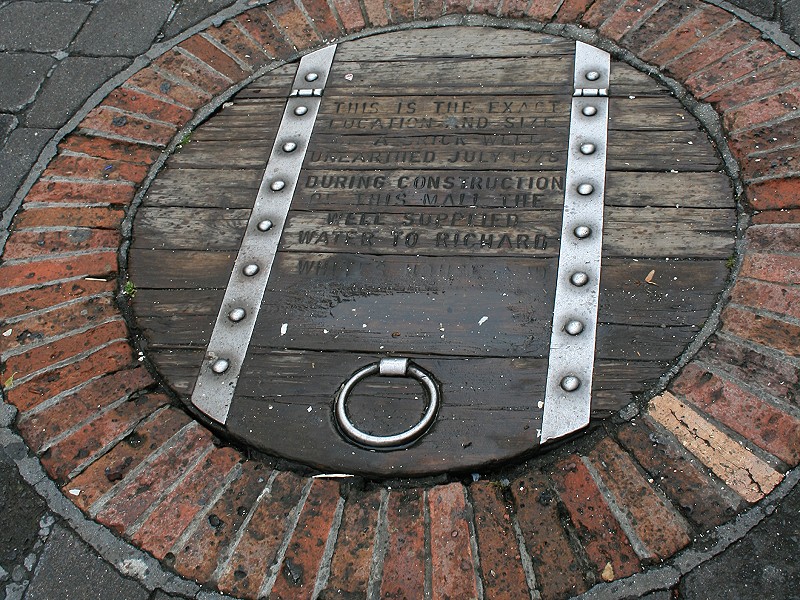
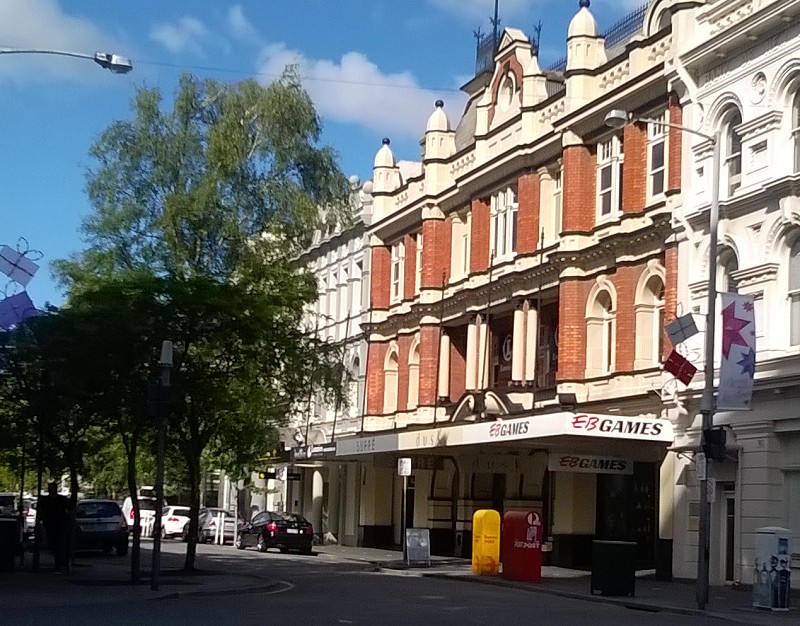
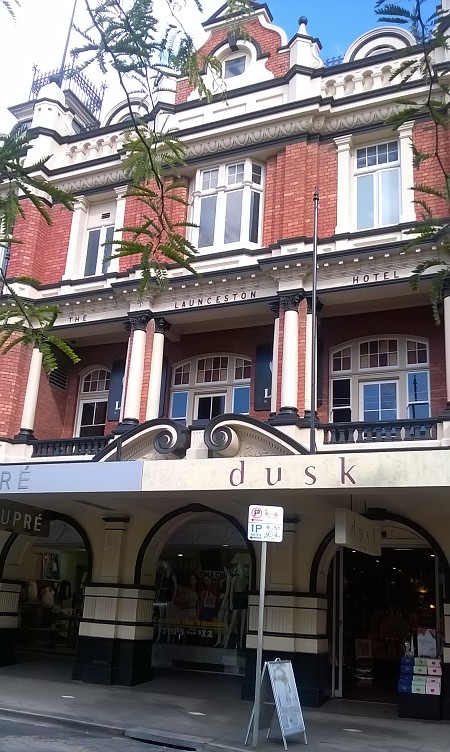
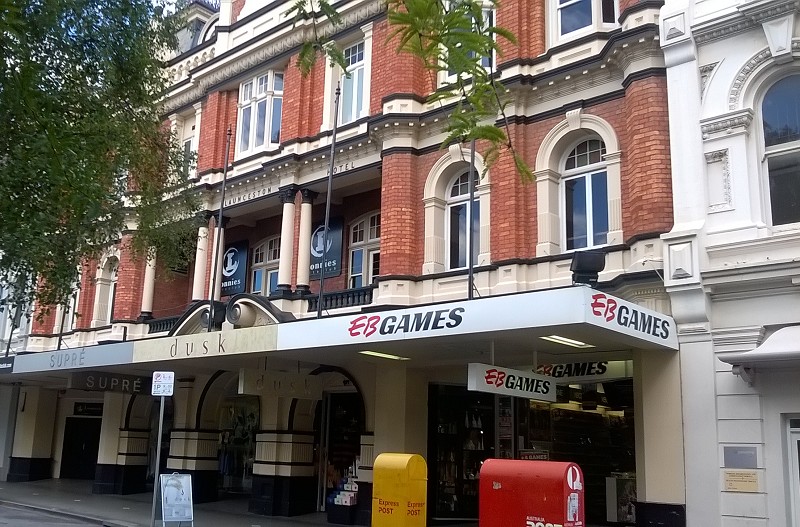
This is quite an extensive history. I would like to find pictures of the main entrance way, however, as I am restoring the original front door to this pub. It is a beautiful art deco piece constructed in blackwood. The current shopfronts had it removed, it languished in a backyard where I discovered it. I want to do a good job particularly to the upper archway. The pub times are still painted on the glass.
That is so cool. I’ll have a look and see if I can find anything of the main entrance this week. I can’t remember seeing any though.
I was wondering if there was ever an Irishman, Jeremiah O’Shannessy, who may have been the licensee of the Launceston Hotel? Possibly from the 1880’s onward?
Not that I’ve come across. Although I only go up to 1900.
There was a Jeremiah Sheehan who had the Riverview Hotel in Charles St in the 1890s.
https://monissa.com/hotels/salmon-ball-riverview/
I was interested in the history of the Launceston Hotel. The Huston family bought in the early 1900s and it remained in their position for 60 years. I am coming to Launceston in early March and I would love permission to view the dining/ballroom. I am hoping the magnificent chandelier is still there. I am the great granddaughter of Ann Jane Huston the proprietor who took over the hotel from her late husband Joseph Huston.